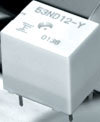

In recent years, electric automotive parts have diversified, leading to an increase in the number of relays used as switching devices as well as variation in the required features of each relay. Further miniaturisation and high contact capability development are demanded, particularly for the electric control unit (ECU) that includes relays due to restrictions in mounting space. Highly reliable relays are also demanded from a safety aspect.
Due to the torque needed for modern smaller electric motors, the current drawn by the motors is increased (the relay loads). As such, the controlling relays need to switch larger currents as well as be smaller in size.
Automotive relays are largely divided into PCB relays that are mounted on printed boards and plug-in relays that are mainly mounted on junction boxes (fuse boxes) by insertion. Relays for junction boxes (mainly the plug-in types) are being shifted to printed circuit relays as a part of size and weight reduction.
Fujitsu's newly-added FBR53-HW Series is intended to replace the large-current automotive applications (electric power steering, blower fans, starters, etc,) in which plug-in-type relays are mainly used. This product is a 40 A relay for printed circuits that Fujitsu believes has the smallest size in the world.
Design concept
At present, the contact arrangement of most PCB relays is the 1-make or 1-transfer arrangement. The following problems arise in the case of miniaturisation and current increase: reduction in the cross-section area for each current; increased internal heating due to deteriorated heat-release.
To overcome this, the FBR53/FBR53-HW adopts a double terminal structure and uses high-conductivity materials. This achieves miniaturisation and capacity increase whilst reducing the average value of conductor resistance plus contact resistance. In a 2-contact parallel connection it is 1,7-2,0 mΩ. (a conventional relay is around 4-5 mΩ). This suppresses Joule heat generation.
Product features
The FBR53-HW type 40 A relay has a current-carrying durability of 5 s at 120 A, 20 s at 100 A, 120 s at 80 A, and continuously at 40 A. The adoption of high-heat-resistant material has enabled a wide temperature range of -40 to 125°C so that it can even be applied in the engine compartment. By adopting LCP as the material for all moulds, reflow mounting is possible.

© Technews Publishing (Pty) Ltd | All Rights Reserved